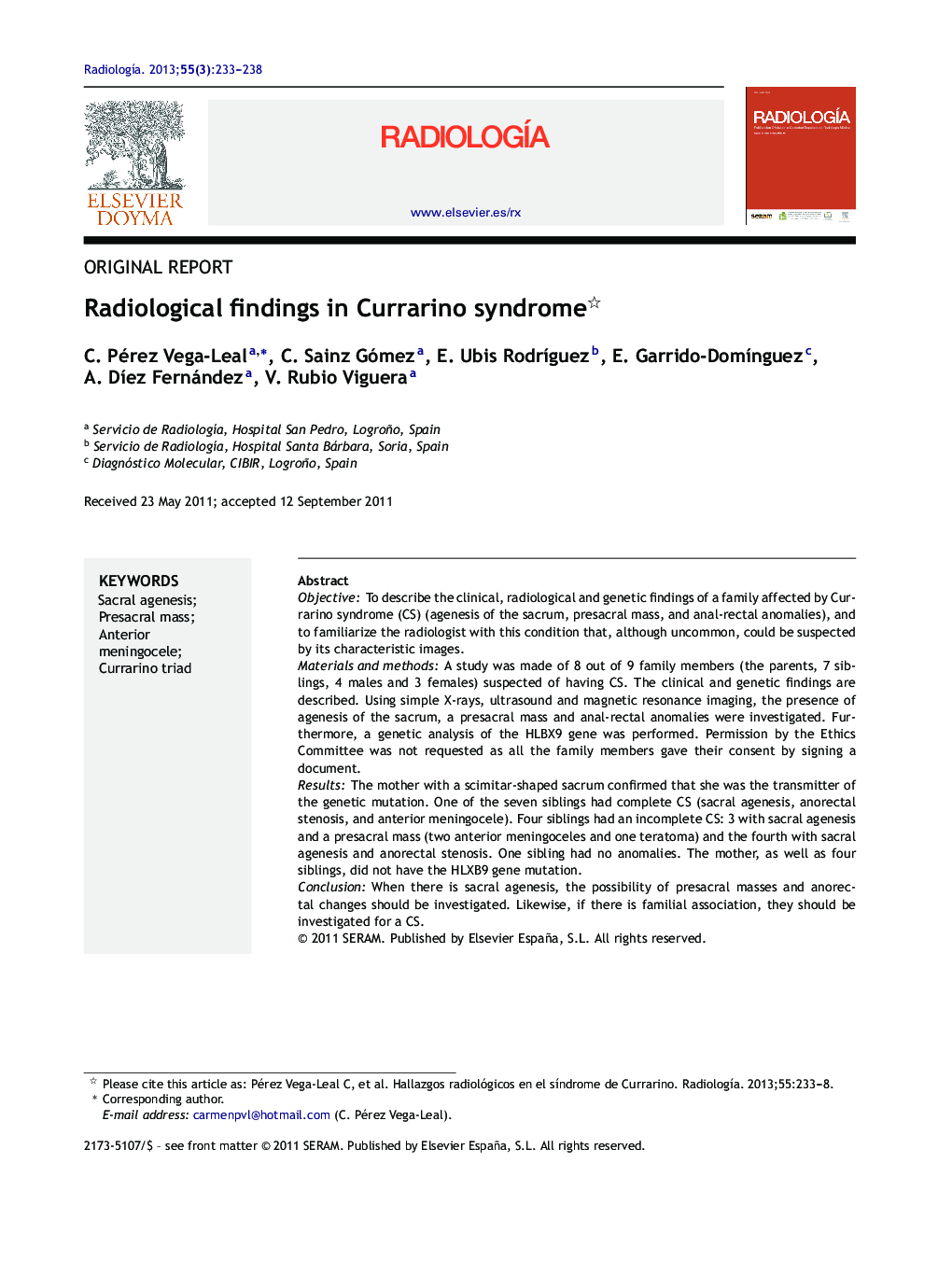| کد مقاله | کد نشریه | سال انتشار | مقاله انگلیسی | نسخه تمام متن |
|---|---|---|---|---|
| 4246522 | 1283573 | 2013 | 6 صفحه PDF | دانلود رایگان |

ObjectiveTo describe the clinical, radiological and genetic findings of a family affected by Currarino syndrome (CS) (agenesis of the sacrum, presacral mass, and anal-rectal anomalies), and to familiarize the radiologist with this condition that, although uncommon, could be suspected by its characteristic images.Materials and methodsA study was made of 8 out of 9 family members (the parents, 7 siblings, 4 males and 3 females) suspected of having CS. The clinical and genetic findings are described. Using simple X-rays, ultrasound and magnetic resonance imaging, the presence of agenesis of the sacrum, a presacral mass and anal-rectal anomalies were investigated. Furthermore, a genetic analysis of the HLBX9 gene was performed. Permission by the Ethics Committee was not requested as all the family members gave their consent by signing a document.ResultsThe mother with a scimitar-shaped sacrum confirmed that she was the transmitter of the genetic mutation. One of the seven siblings had complete CS (sacral agenesis, anorectal stenosis, and anterior meningocele). Four siblings had an incomplete CS: 3 with sacral agenesis and a presacral mass (two anterior meningoceles and one teratoma) and the fourth with sacral agenesis and anorectal stenosis. One sibling had no anomalies. The mother, as well as four siblings, did not have the HLXB9 gene mutation.ConclusionWhen there is sacral agenesis, the possibility of presacral masses and anorectal changes should be investigated. Likewise, if there is familial association, they should be investigated for a CS.
ResumenObjetivoDescribir los hallazgos clínicos, radiológicos y genéticos de una familia afecta de síndrome de Currarino (SC) (agenesia del sacro, masa presacra y anomalías anorrectales) y familiarizar al radiólogo con esta entidad que, aunque infrecuente, podemos sospechar por sus imágenes características.Material y métodosSe estudiaron 8 de los 9 miembros de la familia con sospecha de SC: los padres y 7 hermanos (4 varones y tres mujeres). Se detallaron los hallazgos clínicos y genéticos; y mediante radiografía simple, ecografía y resonancia magnética se investigó la agenesia del sacro y la presencia de masas presacras y anomalías anorrectales. Además, se realizó un análisis del gen HLBX9. No se solicitó el permiso al comité de ética aunque todos los miembros de la familia dieron su consentimiento.ResultadosLa madre con un sacro en cimitarra confirmado era la transmisora de la mutación genética. Uno de los 7 hermanos era un SC completo (agenesia sacra, estenosis anorrectal y meningocele anterior). Cuatro hermanos presentaron un SC incompleto, tres con agenesia del sacro y masa presacra (dos meningoceles anteriores y un teratoma) y el cuarto una agenesia sacra y estenosis anorrectal. Un hermano no tenía alteraciones. Tanto la madre como 4 hermanos presentaban la mutación en el gen HLXB9.ConclusiónAnte una agenesia sacra se deberían investigar posibles masas presacras y alteraciones anorrectales. Así mismo, en caso de asociación familiar habría que descartar un SC.
Journal: Radiología (English Edition) - Volume 55, Issue 3, May–June 2013, Pages 233–238